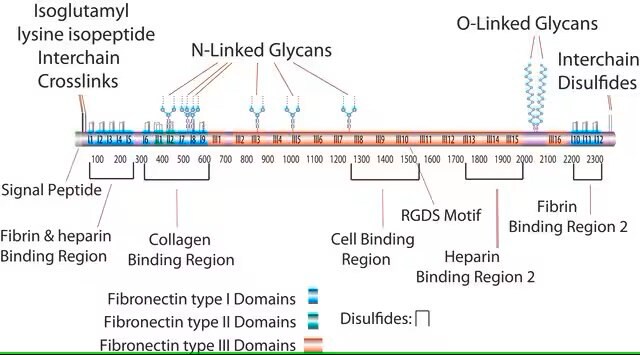F0895
Human Fibronectin
from human plasma, liquid, 1 mg/mL, suitable for cell culture
Synonym(s):
Fibronectin
About This Item
Recommended Products
Product Name
FIBRONECTIN FROM HUMAN PLASMA, liquid, 0.1% (Solution), BioReagent, suitable for cell culture
biological source
human plasma
Quality Level
sterility
sterile
product line
BioReagent
form
liquid
packaging
pkg of 1 mg
pkg of 2 mg
pkg of 5 mg
concentration
0.1% (Solution)
technique(s)
cell culture | mammalian: suitable
surface coverage
1‑5 μg/cm2
solubility
saline: 0.05 M (Tris-buffered)
UniProt accession no.
Binding Specificity
Peptide Source: Collagen
shipped in
wet ice
storage temp.
2-8°C
Gene Information
human ... FN1(2335)
Looking for similar products? Visit Product Comparison Guide
General description
FN occurs as a dimeric protein, linked by two disulfide bonds at the end of C-terminal. Within the fibronectin structure, the domains are compactly arranged close to both the amino and carboxyl terminal of the peptide chains. Moreover, it has been observed that despite arising from a single gene up to 20 distinct variants of this gene have been identified in humans.
Application
Biochem/physiol Actions
Features and Benefits
- Adhesive glycoprotein
- Derived from human plasma
- Recommended surface coverage of 1-5 μg/cm2
Preparation Note
In coating culture surfaces, fibronectin should be diluted in sterile balanced sterile salt solution and coated with minimal volume. Surface should then be air dried for 45 minutes at room temp and can be stored for 2-4 weeks at 2-8°C
Analysis Note
Legal Information
Disclaimer
related product
Storage Class Code
12 - Non Combustible Liquids
WGK
WGK 1
Flash Point(F)
Not applicable
Flash Point(C)
Not applicable
Choose from one of the most recent versions:
Certificates of Analysis (COA)
Don't see the Right Version?
If you require a particular version, you can look up a specific certificate by the Lot or Batch number.
Already Own This Product?
Find documentation for the products that you have recently purchased in the Document Library.
Customers Also Viewed
Articles
Fibronectin (FN) plays crucial roles in extracellular matrix fibril assembly and cellular interactions.
Lung organoids are valuable 3D models for human lung development and respiratory diseases. The 3dGRO™ differentiation protocol generates organoids from human iPSCs in 4 steps.
The extracellular matrix (ECM) and its attachment factor components are discussed in this article in relation to their function in structural biology and their availability for in vitro applications.
The extracellular matrix (ECM) is secreted by cells and surrounds them in tissues.
Protocols
Dilute fibronectin for cell attachment, varying per cell type. Coating protocol, products, and FAQs provided.
Our team of scientists has experience in all areas of research including Life Science, Material Science, Chemical Synthesis, Chromatography, Analytical and many others.
Contact Technical Service










